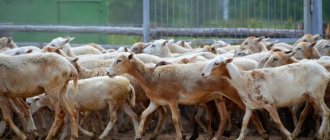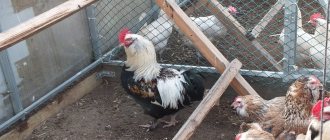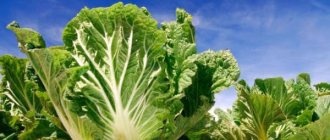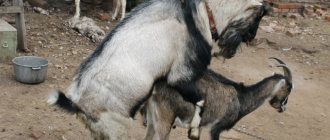Description of the hybrid variety
Appearance of cabbage:
- Leaves. Large, semi-raised, collected in horizontal or slightly raised rosettes. The leaves are oval, waxy, wrinkled. Color – light green. The edges are slightly concave and wavy. The inner leaves are snow-white.
- Heads of cabbage. Large size, dense, round.
- Kocheryzhka. Small size. Length – up to 14-15 cm.
Megaton cabbage seeds
To grow large heads of cabbage, you need to apply a sufficient amount of mineral fertilizers, otherwise the harvest will not please you with its gigantic size
The heads of cabbage grow large, dense, round in shape
Varietal characteristics
Characteristics of Megaton cabbage:
- Mid-season variety. From emergence to harvest - 4.5-5.5 months (136-168 days).
- The weight of heads of cabbage at the stage of technical ripeness is 3.5-4 kg. If you create the most favorable conditions for cabbage, you can grow heads weighing 12-15 kg.
- Heads of cabbage contain 3.9-4.9% sugar. Ascorbic acid (vitamin C) – up to 43.5 mg, proteins – 3%, dry matter – 8-8.8%.
- The taste characteristics are high. The leaves are juicy, crispy, slightly sweet, with a pleasant taste and smell.
- Purpose: fermentation and salting.
- Resistant to clubroot, fusarium wilt, and gray rot.
- Productivity – 650-850 centners per 1 ha, 9 kg per 1 sq. m.
Basic information about the characteristics of Megaton cabbage
We begin the description of the variety by describing the chemical composition of the head of cabbage. The composition determines the nutritional value of the variety and the direction of use. The table shows the percentage of substances beneficial to the human body in 100 grams of Megaton cabbage leaves.
| Name | Quantity |
| Dry matter | 8,7 % |
| Sugary substances | 3,8 % ~ 5 % |
| Ascorbic acid | 39.3 ~ 43.6 mg |
| Protein | 0,6 ~ 3 % |
A high percentage of sugars makes cabbage suitable for pickling. This hybrid can, without a doubt, be grown for autumn fermentation. White sauerkraut has an excellent taste and is stored for a long time.
You can understand if you analyze the reviews of summer residents about cabbage that Megaton heads of cabbage are not suitable for fresh use (preparing salads). The leaves are very dense; when preparing the salad, you will need to mash them well to achieve the desired juiciness and tenderness.
Productivity
Megaton is a productive vegetable crop. The hybrid is grown by large and small agricultural enterprises, so data on cabbage yield appears not per square meter, but per hectare. The maximum yield was recorded - 934 c/ha. Average figures may be lower, from 586 c/ha.
In warm climates, Megaton F1 cabbage has a lower yield characteristic. The variety shows best results in temperate climates. The hybrid is not recommended to be grown in the Volga-Vyatka region. This is recorded by the manufacturer and indicated in the data on the hybrid in the State Register.
Characteristics
Hybrid of average ripening time - 130 - 160 days from germination. The crop is grown using seedlings. Cabbage shows good frost resistance. Adult heads of cabbage do not lose commercial quality during short-term frosts down to -8 °C.
It is immediately necessary to note an important advantage of the hybrid - a short stump (15 cm). Every housewife will appreciate a short stalk: the less waste when processing cabbage, the better
The shape of the heads of cabbage is round, even, slightly flattened. The outer leaves are light green with a slight waxy coating. The leaves are large, oval, slightly corrugated along the edges. The leaf rosette is large.
The inner leaves are white, dense, juicy, collected in a tight head. The heads of cabbage are large, with an average weight of 3–4 kg. There is evidence that it was possible to grow heads of cabbage weighing up to 10–15 kg. You can get such wonderful results with good care and comfortable summer temperatures.
This is interesting: Blueberry leaves - medicinal properties and contraindications
Advantages and disadvantages of the variety
Advantages of the Megaton variety:
- High yield.
- Great taste.
- There is no tendency for heads of cabbage to crack due to temperature changes.
- Tolerates transportation well.
- Resistant to many cabbage diseases.
Megaton has few disadvantages:
- Short-term storage – from 1 to 3 months.
- Freshly harvested heads of cabbage have harsh leaves.
- It is necessary to carefully select the site for planting - the hybrid needs moderate partial shade. Cabbage does not grow well in direct sun.
Description of the cabbage variety Megaton
Megaton cabbage is a variety of Dutch selection. The creator is the seed company Bejo Zaden. The variety was included in the State Register of Russia in 1996. Megaton cabbage is a mid-late hybrid that differs from other hybrid varieties in its high yield and productivity. The leaf rosette is large. The leaves are large, round in shape with a wavy edge, slightly covered with a waxy coating, and light green in color. The head of cabbage has a beautiful rounded-flattened shape and a very dense structure. The stump is small. The average weight of a head of cabbage is from 3 to 5 kilograms, but there are specimens that gain a weight of 15 kilograms. The yield is up to 9 kilograms per 1 square meter. Technical ripeness occurs 136–168 days after emergence.
Megaton cabbage is known for its excellent taste: it is juicy and crispy
Advantages and disadvantages
Among the advantages of the Megaton variety it should be noted:
- high productivity;
- frost resistance;
- the head of cabbage does not crack during sudden changes in weather;
- the variety is resistant to fungal diseases such as fusarium wilt, gray rot, clubroot;
- has high taste qualities;
- not afraid of transportation, good for sale on the market.
The only drawback is the short shelf life, ranging from 1 to 4 months.
Preparing for landing
Before planting, prepare the site and seed material. Soil preparation begins in the fall:
- The soil is being dug up. Remove remnants of weeds and rhizomes found in the soil.
- Apply organic fertilizers before frost. It is best to add humus or rotted manure - this organic matter perfectly stimulates the growth of heads of cabbage. The norm is 10-12 kg per 1 sq. m.
- Apply mineral fertilizers - 30 g per 1 sq. m.
- In the spring, the soil is dug up again, adding urea and potassium sulfate - 40 g per 1 sq. m. m.
In soils with high acidity, yields drop by 20-30%. Lime, wood ash, and dolomite flour are added to acidic soils.
Megaton is planted with seedlings or seeds in open ground. Seed material is prepared for sowing as follows:
- Hardening. Seeds are immersed in warm water (50-55°C) for 20 minutes. Immerse in cool water for 5 minutes.
- Growth stimulation. Immerse for 12 hours in special growth stimulants. The most popular stimulants are Epin and Zircon. Or you can prepare a solution of nitrophoska - take 1 tsp per 1 liter of water. The seeds treated in the stimulator are washed and slightly dried.
Site selection, soil and conditions
How to choose a site:
- The soil. Well-water- and breathable soils are needed. Acidic soils are not suitable - they can provoke clubroot. The best options are chernozems and cultivated loams. Areas that are flooded after precipitation are not suitable - Megaton does not like soils that are too wet.
- Lighting. This hybrid does not tolerate direct sunlight. On the other hand, constant shading is also harmful. To create ideal conditions for cabbage, it is recommended to plant sunflowers or corn between the rows. Planting frequency: every 3-4 rows of cabbage. Megaton grows best in partial shade. It cannot be planted near evergreen bushes and trees - due to a lack of lighting, the yield will decrease.
- Predecessors. Suitable areas are those where cabbage and other cruciferous vegetables - radishes, radishes, turnips, etc. - have not been grown for at least 3-4 years. It is best to plant Megaton after potatoes and tomatoes. It is recommended to change the growing location every year - this reduces the risk of the hybrid contracting cabbage diseases.
Non-seedling planting
When planting seeds directly in open ground, cabbage roots grow deeper than when growing seedlings. This feature increases resistance to drought, but will delay ripening by about 2-3 weeks. Growing seeds by sowing in the ground is easier than the seedling method, but does not guarantee 100% germination.
Features of seedless cultivation:
- Seeds are sown in late April-early May. Exact dates vary by region. Sow the seeds in heated soil, and the temperature outside should be +15°C. In cold soil, seeds do not germinate for a long time; they swell at a temperature of 5°C. The higher the temperature, the faster the seeds will hatch - at 20°C the seeds hatch in 4-5 days, at 10°C - after 2 weeks.
- Holes are made in the ground at intervals of 40-45 cm. The depth of the holes is 3-4 cm. 0.5 liters of water are poured into them.
- The seeds are planted to a depth of 1 cm. 3-4 seeds are placed in one hole. The distance between the rows is 60-70 cm. The seeds are sprinkled with soil on top.
- Sprinkle the crops with sawdust or humus to prevent the formation of a crust that will interfere with the development of seedlings.
- The crops are covered with film - it is pulled over the arcs. You can also use cut plastic bottles and cans for insulation. When the temperature outside rises, the shelter is removed for ventilation. Before the seedlings appear, the soil is moistened with a sprinkler.
- Thinning of seedlings is carried out after the formation of two leaves - 2 sprouts are left. When 3 leaves appear, thin out the plantings again, leaving only one sprout.
Planting seedlings
Growing seedlings lasts 115 days. This method requires a lot of work - you need to grow seedlings, pick them and transplant them into open ground.
How to transplant cabbage seedlings of the Megaton variety into open ground, see the video below:
How to sow seeds for seedlings?
Seeds for cabbage seedlings should be sown from mid-March to the third ten days of April. They grow seedlings in separate glasses - then they skip the picking stage. If seedlings are grown in boxes, after a certain time they have to be planted in pots.
Seeds are prepared for sowing in the usual way - hardened and disinfected. Sowing order:
- The seeds are sown in containers filled with substrate - you can buy it or prepare it yourself. The soil mixture is prepared by mixing humus, sand and turf soil in equal parts. The resulting mixture is disinfected with Fitosporin.
- Place two or three seeds in one glass. Seeds are sown in a row at intervals of 1 cm - this is when sowing in boxes. Between rows - 3 cm.
- Cover with soil, moisten with a spray bottle and cover with film. Until the shoots appear, the container with the crops is kept warm - at a temperature of +20-25°C.
- After 4-5 days, sprouts appear. If seedlings are grown in boxes, the seedlings are thinned out, increasing the gaps between neighboring seedlings to 2 cm. If seedlings are grown in glasses, only one sprout is left - the healthiest and strongest is chosen.
- The seedlings are watered with warm water as soon as the top layer dries.
- Thinned seedlings are placed in a room or greenhouse - during the day the temperature there should be maintained at +18...+20°C, at night - +12...+15°C. Temperature changes are necessary to harden seedlings.
- If necessary, turn on additional lighting to extend daylight hours. With a lack of light, seedlings stretch out and weaken.
It is recommended to sow seeds for seedlings several times - so that the newly growing seedlings can replace those that cannot take root in the beds.
How to pick seedlings?
Picking is carried out after the appearance of the third true leaf. Seedlings from the box are transplanted into glasses. But first the soil is watered to make it easier to remove them. Seedlings are planted in pots, buried to the level of cotyledon leaves.
How to feed the seedlings?
While the seedlings are growing, until they are transplanted into open ground, fertilizing is carried out three times.
Frequency and composition of fertilizers for seedlings:
| Period | Feeding composition |
| After the first leaf appears | Add ammonium nitrate (12 g), superphosphate (20 g), potassium salt (5 g), diluted in water. The dosage is given per 5 liters of water. |
| A week after the first feeding | Water with mullein solution. Ammonium nitrate is also suitable (15 g diluted in 5 liters). |
| A couple of days before transplanting into the ground | Ammonium nitrate (15 g), potassium salt (10 g) and superphosphate (40 g) are diluted in 5 liters. |
How to harden seedlings?
A week before planting, seedlings are subjected to temperature tests:
- Ventilate periodically.
- The seedlings are taken outside, and the duration of the “walks” is gradually increased. After hardening, cabbage better withstands sudden cold snaps.
How to transplant seedlings?
Seedlings are planted on a cloudy day to prevent wilting. The procedure for planting seedlings in the ground:
- Seedlings are ready for transplanting at the age of 45-50 days. They should have three pairs of true leaves, their length should reach 10-12 cm.
- Cabbage is planted in prepared and fertilized beds. Mineral fertilizers are placed in the recesses in the appropriate dosage.
- The root system is dipped in mullein mash.
- The seedlings are carefully placed in the holes, deepening them down to the first leaf - it is forbidden to sprinkle it with soil. Planting pattern: 45x60 cm. Between neighboring plants - 45 cm, row spacing - 60 cm.
Immediately after planting, it is advisable to cover the seedlings with film - it will protect the young plants from the bright daytime sun and cold night temperatures. Strong seedlings quickly take root and adapt to a new location.
Caring for cabbage in open ground
Megaton cabbage is cared for throughout the growing season. It needs regular watering, hilling and loosening.
Watering
How to water Megaton:
- Water temperature is +18-22°C.
- Water the seedlings in the morning or evening.
- If it rains, stop watering until the soil dries out.
- At first, seedlings are watered once every 2-3 days - in hot weather. In cloudy weather, watering is reduced to once every 5-6 days.
- Watering is stopped 2-3 weeks before cutting the heads of cabbage.
5-6 hours after watering, the soil is loosened - this prevents the appearance of a thick crust, impermeable to air and water. Loosen the soil to a depth of 5-6 cm so as not to touch the roots.
Watering methods:
- Furrows. The most convenient method of watering. Furrows 10-12 cm deep are made between rows. This method is effective only on a surface that does not have a slope.
- Sprinkling. Water with a watering can or hose with a sprayer attached. This option is good for sloping terrain.
- Drip irrigation system. Water is supplied through plastic tubes laid along the rows. The method is applicable to terrains of any complexity; it allows you to use water as economically as possible. The downside is the cost of organizing an irrigation system.
Hilling
This agricultural technique is necessary to strengthen the roots and increase yield. 20-25 days after planting - when small forks form, the soil is raked up to the plant. After 15-20 days, the cabbage is hilled again.
Hilling is best done after rain or watering. But first, the leaves lying on the ground are removed. A thin layer of wood ash is sprinkled between the rows.
Features of growing Megaton cabbage, see the video below:
Top dressing
After the seedlings are planted in the ground, they are fertilized three times - for high yields and improved taste of the heads of cabbage.
Frequency and composition of feeding Megaton cabbage:
| Application period | Feeding composition |
| 2 weeks after planting seedlings | For 10 liters of water – 1 liter of liquid mullein. For one plant – 0.5 l. |
| 2 weeks after the first feeding | Similar to the first feeding |
| During the formation of heads of cabbage | For 10 liters of water - 10 g of potassium sulfate and urea. For one plant – 0.5 l. |
Characteristics of cabbage Megaton f1
The cabbage variety Megaton f1 has a good set of characteristics. High yield is combined with excellent nutritional characteristics of the hybrid. The variety is quite frost-resistant and resistant to any manifestations of bad weather.
Content of nutrients in 100 g of Megaton cabbage:
- proteins – from 0.3 to 6 g;
- various sugars – up to 5 g;
- dry matter – up to 8.7 g;
- vitamin C – up to 43.6 mg.
Productivity and fruiting
The stated ripening time for Megaton f1 white cabbage ranges from 136 to 168 days from the time of germination. The yield during industrial cultivation ranges from 600 to 900 centners per hectare, which is superior to many varieties of cabbage. The record yield indicator is considered to be 1053 c/ha recorded in the Moscow region.
When grown individually with an average weight of heads of cabbage of 3-5 kg, the average yield is approximately 9 kg per 1 sq. m. The yield is affected by the amount of sunlight, as well as proper watering. If there is excess moisture, the heads of cabbage begin to crack, and if there is severe drought, fruit development stops.
Timing for harvesting cabbage
Cabbage variety Megaton f1 does not have a clearly limited harvest time. The vegetable is harvested as it ripens. Cabbage grown by seedlings is harvested from mid-August to mid-September. The harvest time for plants planted in open ground can last until mid-October.
Application area
Since cabbage contains a sufficient amount of sugars, it is perfect for pickling. The taste of the hybrid is excellent, it is quite juicy and has a characteristic crunch when eaten.
Its use in salads is possible only after preliminary crushing of the leaves, since they are quite rough, especially in the first months of ripening.
After how long can Megaton cabbage be salted?
Cabbage has a short shelf life. In its unprocessed form, it can be stored in the basement at a temperature of 0-4 ° C for no more than 4 months. For longer storage, it should be salted.
Salting can be done at any time within 4 months after harvest.
Resistance to diseases and pests
When developing Megaton f1 cabbage, special attention was paid to its protective characteristics. The plant has increased resistance to fusarium, gray rot and clubroot
Resistance to viral diseases is also increased.
However, due to its good taste, cabbage can be attacked by a large number of pests. These include mainly insects:
- mole cricket;
- cabbage aphid;
- whitefly;
- cabbage moth.
Therefore, when growing Megaton f1 cabbage, you should definitely take a number of preventive measures to prevent possible pest attacks.
Advantages and disadvantages of the variety
Summarizing the description of Megaton f1 cabbage, we can point out the following advantages:
- high productivity;
- excellent taste and presence of crunch;
- relatively small stalk size for fruits of such mass;
- good resistance to low temperatures and short-term frosts;
- with proper care, the head of cabbage will not crack;
- transports well;
- has high resistance to many fungal and viral diseases.
Flaws:
- short shelf life after harvesting (40-45 days without rejection);
- vulnerability to many pests;
- This is a hybrid, so obtaining seed material on your own is impossible.
Despite the existing disadvantages, white cabbage Megaton f1 is an excellent candidate for cultivation both for personal needs and for business, since its advantages successfully outweigh them.
Disease and pest control
Hybrid Megaton F1 is resistant to many common diseases. But there are diseases that can affect this variety. The best way to avoid damage from diseases and pests is prevention, but if cabbage does become attacked, appropriate fungicides and insecticides are used.
Common cabbage diseases and how to combat them:
| Disease | Symptoms | How to treat? | Preventive measures |
| Downy mildew | There are round spots on the tops. The lower leaves have a purple, gray or white coating. The heads of cabbage take on an irregular shape. | During the fruiting period, spray with 1% Bordeaux mixture. Spray every week. Stop spraying a week before harvesting. | Remove plant debris. Follow the rules of crop rotation. |
| Yellowness of the head of cabbage | Leaves turn green-yellow. | Spray with copper sulfate (5 g per bucket of water). | Timely combustion of affected residues. |
| Blackleg | The stem at the base is dark, watery, rotting. The plant dies. | Bleach is added to the soil - 20 g per 1 square meter. m. | Preventing excess humidity. |
| White rot | The leaves are covered with mucus. They are covered with a white fungus - it looks like a fluffy coating. | Maintain temperature conditions during storage. | Maintain crop rotation and harvest heads of cabbage before the onset of autumn rains. |
| Vascular bacteriosis | The leaves around the edges become yellow. The color of the veins in the affected areas turns black. The heads of cabbage stop growing. | Treat twice with Planriz (10 ml per bucket of water). The interval between spraying is 10 days. | Compliance with crop rotation rules. |
Cabbage pests and measures to combat them:
| Pests | Signs | How to fight? | Preventive measures |
| Aphid | They suck the juice out of the leaves, which weakens the plants and reduces the yield. | Spraying with infusions of wormwood, chamomile, nettle, ash. For 10 liters of water - 300 g of ash. Add 400 g of liquid soap. Treat with Actellik or Intavir according to the instructions. | Sprinkling. You cannot plant cabbage near viburnum - aphids often settle on it. |
| Cruciferous flea beetle | They mainly affect young cabbage. They can completely destroy the crop. | Spraying with garlic-soap infusion: 100 g of soap and 300 g of infusion per bucket of water. Spraying with Karate and Actellik 2-3 times every week. | Spraying with water - this technique is especially useful in extreme heat. Dusting soil and plants with ash. |
| White cabbage | The caterpillars eat the leaves, but can also eat the inside of the head. | Spraying with Fitoverm and Intavir. The treatment is repeated at intervals of 10 days. | Remove butterfly eggs in a timely manner - before caterpillars develop from them. |
Advice from experienced gardeners:
- To prevent damage to cabbage roots by the cabbage fly, thin non-woven material is placed under the plants.
- When butterflies appear, the cabbage is covered with non-woven material on top.
- When caterpillars appear on cabbage leaves, they must be collected immediately - before the leaves are rolled into heads. If you are late, it will no longer be possible to remove pests from the heads of cabbage.
- Insect pests of cabbage do not like the presence of mint, wormwood, and marigolds. They are planted near cabbage beds.
- Pests cannot tolerate the smell of vinegar. Dissolve 1 tbsp in a bucket of water. l vinegar 70%. Spray cabbage with this solution.
- Ants, mole crickets, flies and slugs can be repelled with ammonia.
Advantages and disadvantages of Megaton cabbage - table
| Advantages | Flaws |
| High yield | Large and heavy heads of cabbage require physical effort during harvesting, transportation, and take up a lot of space in the refrigerator and storage |
| Large heads of cabbage with juicy leaves are ideal for pickling | There is a possibility of fungal diseases |
| Can be grown as early cabbage for summer consumption | The price of seeds is higher than for regular varieties, and there are few of them in a bag - usually 10 pieces. |
| Excellent taste without bitterness | |
| All heads of cabbage are aligned | |
| High seed germination |
Video: a specialist from Belarus talks about the characteristics of the Megaton hybrid
How to harvest and store crops?
Heads of cabbage are harvested after the first frost, as soon as the temperature drops to -2°C. The cover leaves are not torn off until cutting, so as not to reduce the yield. The heads of cabbage ready for harvest are so heavy that they barely stay on the stalks. To prevent contact with the soil, the heads of cabbage are supported with supports.
How to harvest Megaton cabbage:
- After tearing off the leaves, the heads of cabbage are placed to dry.
- After drying in the sun, the heads of cabbage are stored until processing in a room protected from frost and precipitation.
- The leaves are somewhat harsh after cutting. When the time comes for pickling, they take on the shape needed for pickling.
- It is important to remove the heads of cabbage on time; if you delay cleaning, they will not be stored for long.
- Heads of cabbage are dug up by the roots. Those affected by caterpillars are sent for food - they must be used first.
High-quality, pest-free heads of cabbage are stored. Before laying them they are kept outside for a day. Then the roots are cut off, but a few outer leaves are left.
Storage conditions:
- Store the harvest at a temperature of +4-5°C. But it can also be stored at lower temperatures - down to -1°C.
- Humidity – 90-98%.
- Good indoor ventilation.
- The heads of cabbage are placed in boxes with the stalks up, or hung from the ceiling.
Harvesting and storage
Megaton cabbage for sale, fresh consumption and pickling can be collected at any convenient time, as needed. You only need to monitor the timing and weather conditions for that part of the cabbage that is planned to be sent for winter storage. Only fully ripened heads of cabbage are stored well, that is, at the age of 140–150 days from germination or 100–110 days from planting seedlings. Harvesting is carried out before frost, in dry and sunny weather. You cannot take frozen heads of cabbage for storage. They will thaw, but will only be suitable for pickling or consumption within two weeks.
The plants are dug up along with the roots, the leaves are torn off, leaving 2-3 coverts on the heads themselves. Then the harvest is laid out for two days under a canopy or in a drying room. Depending on the storage method, the stump is either left or cut off with a sharp knife.
Ways to store cabbage in winter:
- Heads of cabbage are hung by the stump on nails or poles. The forks should not touch each other or the storage walls.
- The stumps are cut off, each head of cabbage is wrapped in several layers of paper, or preferably in cling film, and placed in boxes, baskets, etc.
- The cabbage is covered with wet sand.
- Heads of cabbage without stalks are placed in lattice boxes - this is the most ineffective method of storage.
In the basement or cellar, the temperature should be kept within -1...+2 °C, humidity - 90–98%.
Who to buy Megaton seeds from?
When choosing seeds, gardeners and large vegetable farms choose well-known, proven brands. Today, competing with each other, seed producers are trying to sell the highest quality material possible - they carry out disinfection, check germination, and increase immunity.
Who to buy seeds from:
- In agro. The company has been on the Russian market for more than two decades and has a good reputation.
- IN . One of the most respected companies has been on the market since 1995. Its field of activity is varietal selection and seed production. The seeds of this company are in demand not only in Russia, but also abroad.
- IN . This is a supplier of seed material from the best foreign producers.
Reviews from gardeners
★★★★★
Maria P., amateur vegetable grower, Barabinsk. I have been growing Megaton for 5 years.
And this hybrid has never left me without a harvest, even in rainy and hot years, under the most unfavorable conditions, the heads of cabbage grow very large and juicy. Weight reaches 10 kg. This variety is very good when fermented - it turns out juicy and crispy. ★★★★★
Pavel Sh., summer resident, Moscow region. I grow Megaton without using chemicals.
The heads of cabbage are very large and beautiful, ideal for sale - buyers like them. The seeds are not cheap, but the harvest is excellent. The growth of cabbage is not at all affected by summer temperatures - they grow excellently in any conditions. They practically do not get sick; to prevent diseases and pests, environmentally friendly products are enough - ash, herbal infusions, etc. Hide
Add your review
Megaton F1 is remarkable not only for its unpretentiousness and productivity, but also for its excellent taste properties. If you like sauerkraut, plant Megaton - you will get excellent preparations. And the extra heads of cabbage can be sold on the market - thanks to its excellent commercial qualities, this cabbage is in demand among consumers.
0
0
Copy link
Diseases and pests
Cabbage Megaton: photo of the variety
Despite the fact that the cabbage variety Megaton f1 is very resistant to various diseases and almost all pests avoid it, prevention should not be neglected.
Plant immunity cannot independently overcome cabbage aphids, white-winged aphids, or cope with cabbage moths. Fungal diseases can also occur due to rain and wind.










